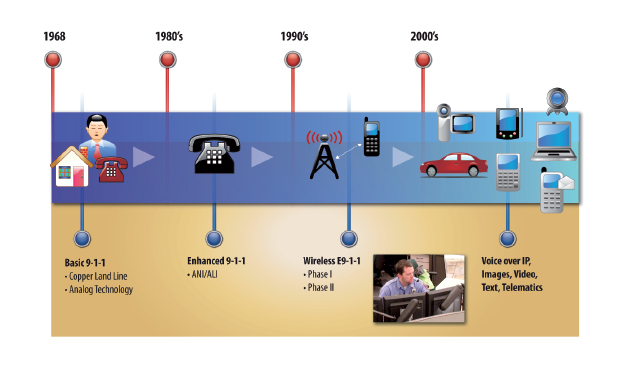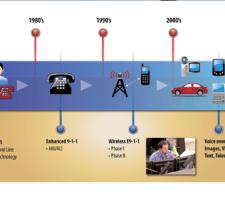
Figure 1: Evolution of the existing 911 system
Continuing developments in telecommunications and public expectation have left the US's legacy, analogue 911 emergency call system trailing. Linda D. Dodge, Public Safety Program Manager for the ITS programme in USDOT's
The 911 system has been a success for 40 years, enabling speedy delivery of emergency services in times of personal and national need. During this time, however, the evolution of consumer and in particular mobile telecommunications technologies has far outpaced the system's capabilities. The current 911 system relies on accurate callback and location data. In addition, text, data, images and video are increasingly common in personal communications and vehicle-based safety services and the general public in the US expects the 911 system to accommodate these communications modes. Today's system can't. Emergency communication networks are becoming less efficient, less technologically advanced and, as a result, less able to provide the public with 911 services.
The analogue infrastructure of the nation's 911 system has essentially not changed since the first 911 call was made in 1968. The 911 system, designed for landline voice calls, was adapted to accommodate teletypewriter (TTY), wireless and some Voice-over-IP (VoIP) calls (Figure 1). This required significant re-engineering and modifications in thousands of 911 systems and Public Safety Answering Points (PSAPs) across the US. That approach is no longer sustainable and a new vision was needed.
Advanced technology offers opportunities as well as challenges. New network and consumer devices enable major advances in the ability of callers and public safety responders to send and receive useful information. Two examples are 911 calls in American Sign Language (ASL) via video, and telematics data transmitted from a car after a vehicle crash. With the trends in telecommunication and IT, current 911 systems should transition to a state-of-the-art infrastructure that will enable the transmission of voice, text, images and other data from more types of communications devices to PSAPs, and on to emergency responder networks.
Advanced technologies also promise increased capabilities to share critical information and data within the emergency response community. For example, precise location data could be transmitted from a crashed vehicle to the PSAP and emergency responders, reducing the time it takes to find the crash, especially in rural areas. Challenges include developing universal interfaces that can extract the necessary data from mobile and IP-based calls and deliver that information to PSAPs. Ultimately, we expect an IP-enabled system to: allow 911 calls from any networked device; provide quicker delivery and more accurate information to both responders and the public; establish increased capabilities for PSAPs to share data and resources, enabling improved emergency responses; and support call access, transfer and back-up among PSAPs, between geographically separated PSAPs and with other authorised emergency organisations.
Why USDOT?
For decades, Emergency Medical Services (EMS) providers have relied on the US Department of Transportation (USDOT) for national leadership. Through the Office of EMS at theIn 2004, Congress enacted the ENHANCE 911 Act (Pub. L. 108-494) "to further upgrade PSAP capabilities and related functions in receiving E911 calls, and to support the construction and operation of a ubiquitous and reliable citizen-activated system". The Act directs NHTSA and Department of Commerce's National Telecommunications and Information Administration (NTIA) to establish a joint programme to facilitate coordination among 911 stakeholders and provide grants for the implementation and operation of E911 services.
The Next Generation 911 (NG911) Initiative, funded by USDOT's
Getting it right first time
The NG911 Initiative has gained broad support in principle. With extensive stakeholder involvement the USDOT developed and published a system architecture; an analysis of costs, value and risks and a transition plan. However, achieving consensus on actual deployment will be challenging and complex. Technical and organisational aspects of NG911 require sustained commitment from key people and organisations, investment of resources and changes in the way work is currently done in both the public and private sectors. Underlying the concept of integrating infrastructures is a complex array of overlapping technological, institutional, deployment and management issues.To determine the technical feasibility of NG911, USDOT conducted a Proof-Of-Concept (POC) demonstration from June through to August 2008. The focus of the POC was not to deliver production-ready systems, software, processes or component designs but to provide a preliminary yet representative showcase of the performance, functionality and value of core NG911 technologies.
The POC developed software and network components demonstrating the desired capabilities of the NG911 system.
The focus of the POC was on the 911 call, from origination to delivery. This included: the ability to send and receive voice, video, text (Instant Messaging [IM]/ SMS) and data; call routing based on caller's location; caller's location identification; increased deaf/hearing-impaired accessibility; transmitting telematics data including speed, vehicular rollover status and crash velocity; and IP networking and security in an emergency communications environment Three test laboratories and five PSAPs hosted the basic infrastructure for the NG911 POC demonstration. The laboratory tests focused on the set-up and routing of calls, while the PSAPs focused on call termination and handling. Three laboratories (the
After separate trials in the laboratory and PSAP environments, the total system was tested. Calls were processed through the complete system and the results recorded. All tests used POC equipment, systems and test data; at no time were live 911 calls handled on the POC system or test calls sent to live 911 systems. A total of 116 functional requirements were tested using use case scenarios and a pass/fail system was used to determine successful demonstration of each functional requirement. In all, 320 individual tests were conducted, with 280 (87.5 per cent) passing the test criteria. Table 1 summarises the results of the POC.
Planning for nationwide deployment
From an engineering perspective, much of the functionality of the envisioned NG911 system is technically feasible. There are, however, operational, economic, political and institutional issues that must be addressed if the NG911 system is going to be successfully implemented. Deployment will likely be a complicated process, requiring the effective and willing cooperation of an array of stakeholders. To address non-technical issues, the NG911 initiative developed a transition plan which frames how government and industry view the deployment of NG911. The NG911 transition plan will be a valuable tool to help plot both public and private sector directions to meet the general public's priorities and needs.Going foward
Realisng the NG911 vision requires leadership and the ability to address needs for funding sources, operational procedures, governance and policy, standards and technology. The ITS JPO transferred the products of the NG911 Initiative to the National 911 Office to continue the promotion and support of NG911. The National 911 Office, a joint programme office of the USDOT and the US Department of Commerce, is housed at the USDOT in the Office of EMS at NHTSA. The products of the NG911 Initiative were key elements of a plan for migrating to a national IP-enabled emergency network, a task which will be completed by the National 911 Office as required by the NET Improvement Act (P.L. 110-283). All primary documents will remain available on USDOT's website and the ITS JPO will continue to support outreach and knowledge transfer activities during this transitional period as NG911 moves closer to becoming a reality.| High-Level Functional Component | Initial Findings |
|---|---|
| Ability to send & receive voice, video, text (Instant Messaging [IM], SMS), and data. | Successfully tested. Location data for SMS-based call is not currently commercially available. There is no method for guaranteed message delivery and some SMS failed to be delivered. In some cases, significant delay was experienced with SMS-based calls. Initially, issues arose with bandwidth and video streaming methods that caused video-based calls to fail. |
| Increased deaf/hearing-impaired accessibility | Successfully tested. Upgrades and technological improvements will be needed at multiple levels. |
| Caller's location identification | Successfully tested for wireline, wireless and IP-based calls. |
| Call routing based on caller's location | Successfully tested use of an ESRP and LoST servers, along with a Business Rules database. Calls were also successfully transmitted from PSAP to PSAP, with acquired data. |
| Transmitting telematics data including speed, vehicular rollover status, and crash velocity | Successfully tested. Demonstrated the ability to easily and automatically transfer important data associated with a vehicle crash. |
| IP networking and security in an emergency communications environment | Successfully tested. Work is still needed to ensure the integrity of the network and system |












